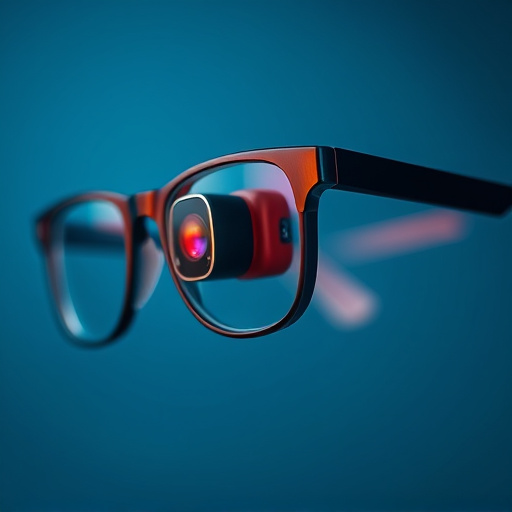Glasses with integrated cameras (smart glasses) represent a significant advancement in wearable tech, offering discreet yet powerful tools for recording and sharing experiences. These devices combine high-quality cameras, microphones, sensors, and processors into eyewear frames, enhancing personal and professional interactions. From capturing travel memories to enabling remote collaboration and medical consultations, smart glasses transform content creation and consumption. Balancing practicality and aesthetics, these gadgets appeal to a broad audience through stylish designs. However, they raise crucial privacy and ethical concerns, necessitating robust data protection measures and established guidelines for responsible usage.
Glasses with a camera built-in are no longer a futuristic concept but an emerging reality. This innovative technology merges eyewear with advanced visual and audio recording capabilities, marking a new era in capture devices. From enhancing personal lifestyles to professional applications, these smart glasses offer unprecedented opportunities for content creation, communication, and surveillance. However, as their adoption grows, so do privacy, security, and ethical considerations surrounding this disruptive technology. This article explores the multifaceted world of glasses with a camera built-in.
Understanding Glasses with Camera Built-In: A New Era of Visual and Audio Capture
Glasses with a camera built-in represent a significant leap forward in wearable technology, marking a new era of visual and audio capture. These innovative devices seamlessly integrate high-quality cameras and microphones directly into the frames of regular glasses, offering users a discreet yet powerful way to record and share their experiences. By combining the functionality of traditional cameras and recording devices with the convenience of everyday eyewear, these glasses offer unparalleled versatility for both personal and professional use.
This emerging technology promises to transform how we document and interact with our surroundings. Whether it’s capturing memorable moments during travel, conducting covert research, or enhancing remote communication, glasses with a camera built-in provide an intuitive and natural means of content creation and consumption. With their compact design and ease of use, these glasses are poised to redefine the way we perceive and share visual and auditory narratives in our daily lives.
How These Smart Glasses Work: Technology and Components
Glasses with a camera built-in, often referred to as smart glasses, are a fusion of fashion and technology. These innovative devices typically incorporate miniaturized cameras, sensors, microphones, and processors within their frames. The camera, usually positioned at the bridge or temple areas, captures still images or video through a transparent or semi-transparent lens. This allows wearers to record moments discreetly without obstructing their vision.
The components work in harmony to enable various functions. Microphones capture audio, ensuring clear voice recording or calls even in noisy environments. Sensors detect movements and gestures, allowing for hands-free control of the device. Processors process data from these sensors and cameras, enabling real-time video streaming, image stabilization, and advanced features like face recognition or augmented reality overlays. These technological advancements make smart glasses a versatile tool for everyday use, offering both convenience and a glimpse into the future of wearable technology.
Benefits and Applications: From Lifestyle Enhancements to Professional Use Cases
Glasses with a camera built-in offer a multitude of benefits and applications, transforming everyday eyewear into versatile tools. These smart glasses enhance personal lifestyles by capturing memories, providing real-time augmented reality experiences, and facilitating video calls hands-free. For instance, outdoor enthusiasts can document their adventures in stunning detail, while professionals like architects and real estate agents can showcase properties virtually.
In professional settings, glasses with a camera built-in have diverse use cases. They facilitate remote collaboration by enabling face-to-face interactions through video conferencing platforms. Medical practitioners can perform teleconsultations, examining patients’ eyes directly via the camera. Furthermore, these glasses can assist in industrial inspections, providing hands-free documentation and real-time data streaming for efficient quality control.
Design and Comfort: Navigating the Balance Between Functionality and Fashion
In designing glasses with an integrated camera and audio functionality, striking a balance between practicality and aesthetics is paramount. These innovative devices blend wearable technology with fashion, catering to users seeking both advanced features and stylish looks. The physical design must consider weight distribution, lens shape, and frame materials to ensure all-day comfort, especially for those who wear glasses regularly. Ergonomic features and adjustable frames can enhance user experience, ensuring the device fits securely without causing discomfort or pressure points.
Fashionability is another critical aspect, as these smart glasses aim to appeal to a wide range of users beyond tech enthusiasts. Incorporating trendy styles, color options, and customizable designs allows wearers to express their personal taste while enjoying the benefits of an integrated camera and audio system. This blend of functionality and fashion positions glasses with built-in cameras as versatile accessories that seamlessly integrate into various lifestyles and settings.
Privacy, Security, and Ethical Considerations: Addressing Concerns with Glasses Cameras
The rise of glasses with built-in cameras brings both exciting possibilities and significant privacy, security, and ethical concerns. As this technology advances, it’s crucial to address potential issues related to surveillance and data collection. Wearers may need to be mindful of their surroundings, as these devices could capture sensitive information or intimate moments without the user’s explicit consent.
Privacy advocates argue that glasses with cameras could foster a culture of constant recording, eroding individual privacy. Additionally, the security of personal data collected by these devices is essential. Developers must ensure robust encryption and secure storage to prevent unauthorized access to video and audio recordings. Ethical considerations also come into play when discussing the responsible use of such technology, including clear guidelines on data retention, deletion, and user control over their visual and auditory footprints.
